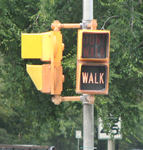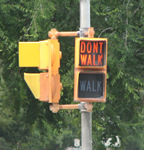Pedestrian Signals
Signals convey important messages and help pedestrians and traffic move smoothly.
 |
Steady WALK Signal
|
 |
Flashing DON'T WALK Signal
|
 |
Steady DON'T WALK Signal
|
Pedestrians Class Comedy - Sign up for Comedy Safe Driver
Learn Defensive Driving and Pedestrian Safety
Welcome to Comedy Safe Driver, where you can master defensive driving techniques while having a great time! Our course not only teaches you how to become a safer driver but also covers important aspects of pedestrian safety. We believe that learning should be fun, and that's why we combine humor with valuable knowledge.
Why Pedestrian Signals Matter
Signals play a crucial role in ensuring the safety of pedestrians and facilitating smooth traffic flow. Understanding the meanings of different signals is vital for every driver and pedestrian. Let's take a closer look at pedestrian signals:
Pedestrian Signals: Steady WALK Signal
Pedestrian signals are an important part of traffic control systems that help regulate the movement of pedestrians and vehicles at intersections. The steady WALK signal is one of the indications provided to pedestrians to inform them when it is safe to cross the street.
When the pedestrian signal displays a steady WALK symbol, it typically appears as a white walking figure or a text display that says "WALK." This signal indicates that pedestrians have the right-of-way and are permitted to proceed across the street in the designated crosswalk.
However, even with the steady WALK signal indicating that it's safe to cross, pedestrians should exercise caution and remain vigilant. Here are some important points to keep in mind:
-
Watch for turning vehicles: While the steady WALK signal grants pedestrians the right of way, it's crucial to be aware of vehicles that may be making turns at the intersection. Turning drivers may not always see or yield to pedestrians, so it's essential to make eye contact with drivers and ensure they have noticed you before crossing.
-
Be aware of your surroundings: Pay attention to traffic in all directions, not just the direction you intend to cross. Look for any approaching vehicles, even if you have the right-of-way. It's essential to stay alert and ready to react to any unexpected situations.
-
Follow additional signals and signs: Pedestrian signals may be accompanied by other traffic control devices, such as traffic lights or crossing signals. Always obey these additional signals and signs, even if the steady WALK signal is displayed. For example, if a countdown timer indicates that there is not enough time to safely cross, it's better to wait for the next signal cycle.
-
Avoid distractions: Avoid using electronic devices or being distracted while crossing the street. Keep your focus on the road and maintain awareness of your surroundings.
-
Be visible: Make yourself visible to drivers by wearing reflective clothing, especially during low-light conditions or at night. This can help drivers see you more easily and reduce the risk of accidents.
Remember, pedestrian signals are designed to enhance safety, but it's crucial to use them in conjunction with good judgment and awareness. Always prioritize your safety when crossing the street, even when the steady WALK signal is indicating that you have the right-of-way.
Pedestrian Signals: Flashing DON'T WALK Signal
Pedestrian signals play a vital role in ensuring the safety of pedestrians at intersections. The flashing DON'T WALK signal is an important indication provided to pedestrians to inform them about the remaining time they have to cross the street safely.
When the pedestrian signal displays a flashing DON'T WALK symbol, it typically appears as a flashing orange or red hand or a text display that says "DON'T WALK." This signal indicates that pedestrians should not start crossing the street if they have not already begun. It is a warning that the remaining time to cross safely is limited.
If you are already in the street when the DON'T WALK signal starts flashing, you should continue crossing to the other side promptly and safely. The flashing DON'T WALK signal does not mean you have to immediately stop or turn back. It is a signal to inform you to complete your crossing as quickly as possible.
However, if you haven't started crossing the street yet when the flashing DON'T WALK signal begins, it is best to wait on the curb or sidewalk until the next WALK signal is displayed. This allows you to ensure your safety by avoiding crossing when there is limited time or an increased risk of conflicts with turning vehicles.
Regardless of the pedestrian signal, it is essential to remain vigilant and aware of your surroundings at all times. Even if you have the right-of-way, you should never assume that all drivers will yield to you. Always keep an eye on traffic and be prepared to react to any potential hazards.
Here are some additional points to consider:
-
Observe traffic flow: While the flashing DON'T WALK signal indicates limited time to cross, it's important to assess the traffic flow before starting or continuing your crossing. If there is a significant number of vehicles approaching or turning, it may be safer to wait for the next WALK signal.
-
Use pedestrian crosswalks: Whenever possible, use designated crosswalks to ensure visibility and make it easier for drivers to anticipate your movements. Crossing outside of designated areas can increase the risk of accidents.
-
Avoid distractions: Just like with the steady WALK signal, it is important to avoid distractions such as using electronic devices or being engrossed in conversations. Keep your focus on the road and your surroundings.
-
Be cautious at night: During low-light conditions or at night, it becomes even more crucial to make yourself visible to drivers. Wear reflective clothing or carry a flashlight to increase your visibility.
Always prioritize your safety when crossing the street, and remember that pedestrian signals are designed to guide and protect you. Use them in conjunction with good judgment and awareness to prevent accidents and ensure a safe crossing experience.
Pedestrian Signals: Steady DON'T WALK Signal
The steady DON'T WALK signal is an important indication provided to pedestrians at intersections to ensure their safety and guide their behavior. When the pedestrian signal displays a steady DON'T WALK symbol, it typically appears as a solid orange or red hand or a text display that says "DON'T WALK."
If you haven't started crossing the street yet and the steady DON'T WALK signal is displayed, it means that you should stay on the curb or sidewalk and refrain from stepping off to cross the street. The steady DON'T WALK signal indicates that it is not safe to begin crossing at that moment.
It's important to prioritize your safety and exercise patience when faced with a steady DON'T WALK signal. Here are some key points to consider:
-
Wait for the next WALK signal: The steady DON'T WALK signal informs pedestrians that they should wait for the next WALK signal to begin their crossing. This signal is typically displayed when there is not enough time for pedestrians to safely complete their crossing before traffic resumes.
-
Assess traffic conditions: While waiting for the next WALK signal, it's essential to observe the traffic conditions. Check for approaching vehicles, including turning vehicles, and ensure that the traffic has come to a complete stop before attempting to cross.
-
Follow additional signals and signs: Pay attention to any additional traffic control devices, such as traffic lights or crossing signals, that may accompany the pedestrian signals. Always obey these signals and signs, even if you have the right of way.
-
Be cautious at all times: Regardless of the pedestrian signal, it's important to be cautious and aware of your surroundings when crossing the street. Even if you have the right-of-way, always look out for potential hazards and make eye contact with drivers to ensure they have noticed you before crossing.
At Comedy Safe Driver, we understand the importance of pedestrian safety and defensive driving. Our course covers a wide range of topics, including pedestrian signals, right-of-way rules, and how to anticipate and respond to potential hazards on the road.
Remember, pedestrian signals are designed to enhance the safety of pedestrians and ensure smooth traffic flow. It's important to use them in conjunction with good judgment and awareness to make informed decisions and prevent accidents.
Sign Up Today!
Don't miss the opportunity to improve your driving skills and become a safer driver. By signing up for Comedy Safe Driver's defensive driving course, you'll not only learn valuable techniques but also enjoy a hilarious and engaging experience. Remember, laughter is the best way to learn!
To register for the Comedy Safe Driver course and gain essential knowledge about pedestrian safety, click here.















